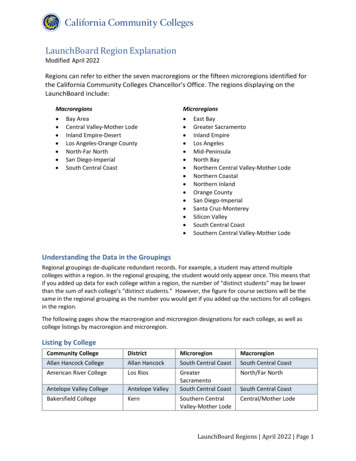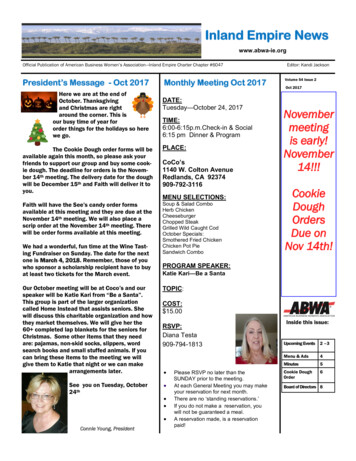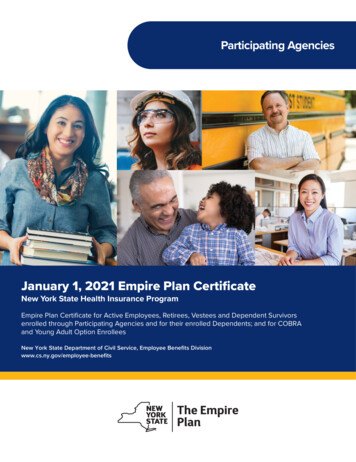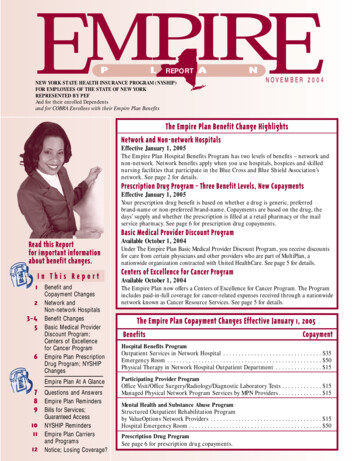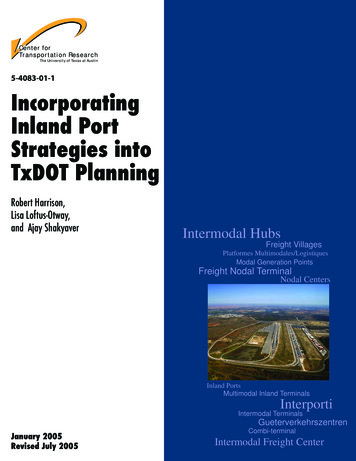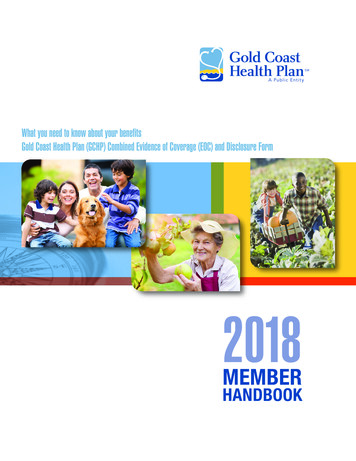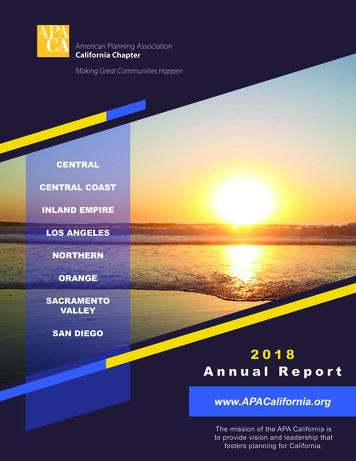
Transcription
CENTRALCENTRAL COASTINLAND EMPIRELOS ANGELESNORTHERNORANGESACRAMENTOVALLEYSAN DIEGO2018Annual Reportwww.APACalifornia.orgThe mission of the APA California isto provide vision and leadership thatfosters planning for California.
Contents1348Chapter President StatementCalifornia Chapter Board Information3 2018 Chapter Boardmembers3 Management Association/ContractorsRegion VI Representatives ReportVice President Portfolios/Programs8 Administration10 Policy and Legislation12 Professional Development14 Conferences16 Marketing and Membership16 University Liaisons17 Membership Inclusion17 Young Planners Group18 Great Places20 Public Information1821 Commission and Board RepresentativeAppointed Directors & Affiliate Organizations22 Chapter Historians24 California Planning Foundation26 California Planning Roundtable2428 Planner Emeritus NetworkLocal Sections (Directors)30 Central33 Central Coast34 Inland Empire35 Los Angeles37 Northern39 Orange40 Sacramento Valley44 San Diego2018Annual Report22018 APA California Annual Report
APA CALIFORNIAPresident’s StatementPete Parkinson, AICPWhen I began my term as Chapter President in January2017, I did not foresee how much the world would change overthe next two years. Even though our job as planners is to plan forthe future, no one was preparing to cope with issues like undercutting the 2020 census, gutting federal agencies like HUD andthe EPA, an assault on western public lands, and climate-changedenial as official US government policy, just to name a fewprominent national headlines. Our reality has shifted in so manyways.Here in our home state, the two most destructive wildfires inCalifornia history occurred only thirteen months apart: here in myhome town of Santa Rosa and last November with the near-complete destruction of the town of Paradise. These catastrophicevents have struck at the heart of our communities in ways thatare central to our work as planners. Housing, infrastructure, communication systems, the environment and economic development have all been dealt serious and long-term blows and thosedamages extend well beyond the communities that burned.And—no surprise—those impacts have hit our most disadvantaged residents the hardest. But—again, no surprise—some ofthe first calls I got after the fires started here in Sonoma Countywere from planning colleagues up and down the state, askinghow they can help. It was inspiring and uplifting.At the same time, it is also more apparent than ever that California is now a national and international leader for those whohope for a more enlightened and inclusive future. Whether youcall it resistance or leadership, people are watching our stateclosely and that makes this a very exciting time to be a plannerin California. Whether you are a planner working on climatechange initiatives, planning to make your communities more resilient, building (or rebuilding!) more affordable housing, workingtoward a more inclusive planning process that gives voice tothose who have too often been left out, or striving to improve environmental justice and equity outcomes in California’s disadvantaged communities, California planners are leading the way and Ihope you too are inspired for the tough work ahead.With this meta-view in mind, here are a few APA Californiahighlights from the past two years: Our highly successful state conferences enabled the Chapterto fund several initiatives that have gone wanting in the past.For example, we have now funded the digitizing and cataloging of the California Planning Archives housed at Cal StateNorthridge. The Chapter also provided matching funds for anew California Planning Foundation Scholarship in memory ofFrank Wein, FAICP. We also purchased webinar softwarethat has already provided several highly successful and wellattended webinars, with much more to come. APA California’s well-established Policy and Legislation program continues to grow in influence in Sacramento. The legislature passed major housing legislation that will affectplanners’ work for many years to come and APA California’slobbying and grass-roots advocacy helped shape the housingbills in ways that will make them more practical and effective.This work is by no means done as legislators and a new governor continue to grapple with California’s ongoing housing affordability crisis, and APA California remains on the front lines. APA California held highly successful planning conferences inSacramento (2017) and San Diego (2018). Both conferencesattracted around 1,500 attendees and filled our venues to capacity. The quality and value of the conference sessions wasextraordinary and received high marks from attendees. In SanDiego, the Chapter celebrated it’s 70th Anniversary with a fascinating presentation of California planning history put together by our Chapter Historians, Steve Preston, FAICP, andLarry Mintier, FAICP.12018 APA California Annual ReportContinued on page 2“Whether you call itresistance or leadership,people are watching ourstate closely and thatmakes this a very excitingtime to be a planner inCalifornia.”
Continued from page 1PRESIDENT’S STATEMENT We have increased Planning Commissioner involvement inAPA activities, largely as a result of the work of StephenHaase, AICP, the Board and Commissions representative onthe APA California Board during 2017 and 2018. This effort included a very successful Planning Commissioner training dayat both conferences. The Chapter Board of Directors added a new voting memberin 2018, the Vice President for Equity and Diversity, and appointed Miroo Desai, AICP, to that position. This board position will focus on promoting diverse and inclusive perspectiveswithin APA California and the planning profession, includingrecruitment of planners of color as members and leaderswithin our organization. We recognized Great Places in California at our conferences,including Downtown Santa Monica, Old Towne Plaza in theCity of Orange, the City of Lafayette, Todos Santos Plaza inConcord and Mt. Uhmunum Regional Park in Santa ClaraCounty. Two California places—Mill Creek Linear Park in theCity of Bakersfield and Old Towne Plaza in Orange—havewon coveted “Great Places in America” awards from APA National. At the 2018 National Planning Conference in New Orleans,seven California planners were inducted into the AICP Collegeof Fellows, including former APA California Board members,Betsy McCullough, FAICP, and Linda Tatum, FAICP.Of course, planners are inherently forward-thinking, right? I’mhopeful that the arc will bend in a more just and humane direction in 2019, not just here in California, but in our nation and theworld. Planners already have their shoulders to the wheel in thiseffort, which is encouraging. Here’s what I see on our horizon: APA California’s eight regional Sections will continue tostrengthen their connection with members by providing educational, networking and downright fun opportunities for planners to connect and collaborate. Planning is well underway for our next conference, September 15-18 in Santa Barbara. I feel like our conferences getbetter and better every year and I know this will be no exception. California’s very own Kurt Christiansen, FAICP, has takenover as President of the American Planning Association, ournational parent organization. Kurt is a past president of APACalifornia, and he has the vision and dedication to keep ourprofession moving forward, even if he is moving to Virginia. Speaking of APA national, our Association started new membership programs in 2017 that will make it easier (i.e., less-expensive) for students and new members to join APA. APA alsohas a new AICP Candidate Program to pave the way for recent planning graduates to become certified planners. This isimportant because these young professionals are, quite literally, our future, as a profession and as communities. Last but by no means least, I extend a warm welcome to APACalifornia’s new Chapter President, Julia Lave Johnston. Juliahas the energy and vision to move our Chapter forward and Ilook forward to working with her!And finally, let me close by thanking all of you who have chosen to be APA California members these past two years and especially those of you who have made the extra effort to becomecertified planners. We are a strong organization and a strongprofession because of you. Thank You! APA California will continue to “up its game” on professionaldevelopment, providing our members with high-quality professional education, delivered right to your desktop (in addition toour usual channels). Distance education will become a newand stronger focus.“ I’m hopeful that the arc will bend in a more just and humane direction in2019, not just here in California, but in our nation and the world.”22018 APA California Annual Report
2018 Board of DirectorsChapter Officers Pete Parkinson, AICPPresidentSung H. Kwon, AICP, MCRPVP Administration, through 10/2018Derek Wong, AICPVP Administration, effective 12/2018Hanson Hom, AICPVP ConferencesMary P. Wright, AICP, LEED AP NDVP Marketing and MembershipJohn Terell, AICPVP Policy and LegislationKimberly Anne Brosseau, AICPVP Professional DevelopmentMarc Yeber, ASLAVP Public InformationJulie Lave JohnstonPresident ElectJuan Borrelli, AICPCPF PresidentStephen M. Haase, AICPCommission and Board RepresentativeJohn HolderStudent RepresentativeLocal Section Directors Rob Terry, AICPCentral SectionChristopher Williamson, AICPCentral Coast SectionJohn E. HildebrandInland Empire Section Ashley Atkinson, AICPLos Angeles SectionSharon Grewal, AICPNorthern SectionNicholas Chen, AICPOrange SectionRobert G. Lagomarsino, AICPSacramento Valley SectionRachel A. Hurst, AICPSan Diego SectionAppointed Members Asha Bleier, AICPAICP CoordinatorJ. Laurence Mintier, FAICPChapter Historian, NorthernSteven A. Preston, AICPChapter Historian, SouthernKacey LizonConference Program CoordinatorGabriel BarrerasDigital Media Coordinator, WebsiteMelanie EmasDigital Media Coordinator, Social MediaGreg Konar, AICPDistance Education DirectorAl Zelinka, AICPFAICP Co-CoordinatorKurt Christiansen, FAICPFAICP Co-CoordinatorMiroo Desai, AICPMembership Inclusion CoordinatorNorthernManagement Association and Contract Staff Sande GeorgeExecutive Director and LobbyistLauren de Valencia y SanchezExecutive Assistant and LobbyistFrancine FarrellAssociation and Accounting ServicesATEGO ResourcesLaura MurphyAssociation and CertificationMaintenance ServicesNew Horizon Enterprise Professional Liability InsuranceHeffman Insurance Brokers Dick LemonInsurance AgentMcClatchy Insurance32018 APA California Annual ReportNicholas P. MaricichNational Policy and LegislativeRepresentativePamela Wu, AICPStatewide Program CoordinatorChris PahuleState Awards Coordinator, NorthernAndre Sahakian, AICPState Awards Coordinator, SouthernMirle Rabinowitz BussellUniversity Liaison, SouthernNina IdemudiaYoung Planners CoordinatorNon-Voting MembersDorina BlytheGraphic Design ServicesGranDesigns, Inc.Marco A. MartinezAPA California AttorneyBest, Best & Krieger, LLCErica GutierrezMembership Inclusion Coordinator,Southern Kristen Asp, AICPAPA Board Director, Region 6Marissa Aho, AICPAICP Commissioner, Region 6Lance MacNivenAPA Student Representative,Region 6Robert Paternoster, FAICPPlanner Emeritus Network, PresidentColeen Clementson, AICPCalifornia Planning Roundtable,PresidentEllie Fiore, AICPCalPlanner Assistant EditorChristopher JaimeWebsite ManagementDigital Gear, Inc.Deene AlongiConference ManagementBusiness Event StrategistCarol MalinProofreading and Editing ServicesWordsmith.biz
REGION VI REPRESENTATIVES REPORTNational APANATIONAL APA 2018 SUMMARYIt is an honor and privilege to serve on the National APABoard of Directors as the representative elected by the membersof Region VI. The Board of Directors meets 3-4 times a year.Below is a summary of actions the Board took or embarked on in2018.Kristen Asp, AICPAPA Board of DirectorsElected by Region VIEquity, Diversity and Inclusion – The APA Board adoptednew diversity and inclusion statements and strategy into the APADevelopment Plan. Our goal is to promote more inclusive, just,Kristen Asp is a principal planner for the City of Glendale,California. Kristen has served as vice president of administrationfor APA's California Chapter, section director for the APA Los An-geles Section, vice chair of the APA Membership Committee, andvice chair of the APA Awards Task Force. She earned her bachelor's degree from California Polytechnic State University, SanLuis Obispo, and master's degree from Woodbury University.and equitable communities through a planning profession as diverse and inclusive as the many communities we serve; and toequip planners to perform inclusive planning and work effectivelyacross diverse communities. Aspects of the strategy include expanding representation in the profession, addressing barriers torecruitment and retention in leadership and in the profession,and building capacity for inclusive planning practices amongplanners, and through work with our partners.“Our goal is to promote more inclusive, just, and equitable communities througha planning profession as diverse and inclusive as the many communities weserve; and to equip planners to perform inclusive planning and work effectivelyacross diverse communities.”www.planning.orgJAPApractices and consistency in design, lay-the Journal of the American Planning As-design will debut with the first issue ofThe Board approved a redesign ofsociation, which will include a modern,recognizable brand identity for JAPA. Itthe selection of Dr. Ann Forsyth as JAPA'sthe 2019 calendar year.in January 2019. Dr. Forsyth is a Profes-Dr. Sandra Rosenbloom, professor ofwill also consider JAPA’s diverse audi-Community and Regional Planning at theplanners, students, and others interestedher term as Editor of the Journal of theence, which includes scholars, practicingin the profession. The journal’s new lookwill include a community-friendly andpeople-focused tone that reflects the cul-ture of the profession, and will apply bestThe APA Board of Directors approvedout, readability and aesthetics. The newUniversity of Texas at Austin, completedAmerican Planning Association at theend of 2018. APA thanks Dr. Rosen-bloom for her expertise and dedication toJAPA.42018 APA California Annual Reportnew editor. She begins a five-year-termsor of Urban Planning and Director of theMaster in Urban Planning degree programat Harvard Graduate School of Design.She also co-directs the Healthy PlacesDesign Lab and has been both an associate editor of JAPA and a member of theeditorial board. Dr. Forsyth also serveson the APA Board of Directors.Continued on page 5
Continued from page 4REGION VI REPRESENTATIVES REPORTNational APAPolicy and Advocacy – The Board identified four legislativePlanning Home Initiative – The Board approved a newpriorities: infrastructure, housing choice and affordability, federalset of housing affordability policy principles. Planning Homeon a new policy guide on social equity and inclusive growth, andand advocates use planning to address our housing affordabilitydata, and safe and healthy communities. Work is also underwayupdated guides on housing and surface transportation.The Planners' Advocacy Network reached an all-time high inmembership at 9,000!The sold-out 2018 Policy and Advocacy Conference in Sep-tember was the best-attended ever, with a deep program that included leadership training, mid-term election insights, andsessions on housing issues and Planning Home, equity, Au-tonomous Vehicles, and tax reform. The Daniel Burnham Forumon Big Ideas, presented in partnership with the Lincoln Instituteof Land Policy, began the conference with an expert panel dis-cussion on land-value capture as a funding source for infrastructure. It's now a free course in APA Learn!Planner’s Day on Capitol Hill boasted a record number ofparticipates and meetings with officials.aims to reshape the way planners, developers, policy makers,crisis based on six principles: Modernize State Planning Laws Reform Local Codes Promote Inclusionary Growth Remove Barriers to Multi-family Housing Turn NIMBY into YIMBY Rethink FinanceThe initiative will address systemic housing issues throughthe collaboration of legislators, planners, developers, and resi-dents; it will include training and tools for APA members, as wellas direct outreach to various stakeholders.Continued on page 6APA FOUNDATIONtaled almost 88,000. The Foundationendeavor—FutureShape—a collaborativetook big steps toward fulfilling its missionstudent members. Support for this pro-reaching agenda for the planning profes-The reinvigorated APA Foundationto advance planning by supporting threepriority initiatives: scholarships, community assistance, and research.Contributions to the Foundation in2018—from generous members, APAchapters and divisions, and others—to-awarded academic scholarships to eightgram also was provided in part by a grantfrom the Pisces Foundation, which seeksways to accelerate to a world where people and nature thrive together.Behind the scenes, the Foundationmade great progress on its first signature52018 APA California Annual Reporteffort to produce a wide-ranging, far-sion. The need for such a framework iscritical when smart technologies, climatechange, and other fast-moving trends aretransforming the earth's natural and builtenvironments.
Continued from page 5REGION VI REPRESENTATIVES REPORTNational APAbig gain in APA membership was largely due to the free studentProfessional Education – APA Learn was launched in latemembership program initiated in 2017. Offering a new "New2018 providing a new online educational platform that offers hun-Member" category with reduced dues for two years also con-dreds of hours of professional education on subjects that are im-tributed to growth.portant to APA members including session recording from theThe student programs offer of free membership in up to five2018 National APA Conference in New Orleans. It’s a convenientway to continue planning education and earn CM credits, includ-APA divisions had a major impact on membership in all 21 divi-relevant educational opportunities in response to members'FY 2017 to 42,617 a year later — an 89 percent gain.sions. Total division membership grew from 22,507 at the end ofing those credits in law and ethics. APA Learn will add fresh andneeds and advances in planning. Experience feature highlightsinclude custom learning portfolios, seamless CM logging, andbookmarking.Membership – Total APA membership increased by almost13 percent during the 2018 fiscal year. On September 30—thelast day of FY 2018—APA had 42,906 members, including16,733 AICP members (40 percent of total membership). The“APA Learn will add fresh andrelevant educational opportunities inresponse to members’ needs andadvances in planning.”www.planning.orgFELLOWS CLASS OF 2018At NPC18 in New Orleans, 64 AICP Kathrin Moore, FAICP –Northern Section Foundation Board of Directors –Linda Tatum, FAICP from Long Beach,CA and Kurt Christiansen, FAICP frommembers were inducted into the College Carl Morehouse, FAICP –Each Fellow has achieved excellence in Linda Tatum, FAICP – Divisions Council, Chair – David Heidi Tschudin, FAICP – Chapter Residents Council, Pastof Fellows, the Institute's highest honor.professional practice, teaching and mentoring, research, or community serviceand leadership. They continue to serveAPA and the planning profession asteachers, leaders, mentors, and volun-Central Coast SectionLos Angeles SectionSacramento Valley SectionNational Leadership: Several othersteers.in the Chapter serve in National Leader-ductees from California!Leadership roles are the following:Congratulations to the seven in- Susan Harden, FAICP –Orange Section Laurie A. Johnson, FAICP –Northern Section Betsy McCullough, FAICP –ship positions. Those serving in APA President Elect – Kurt Christiansen,FAICP from Azusa, CA Student Representative Council,Region VI Representative – AlexanderYee from Los Angeles, CA (USC)San Diego SectionAzusa, CAFields, AICP from San Francisco, CAChair – Shane Burkhardt, AICP fromHuntington Beach, CA Economic Development Division,Chair – Lance Harris, AICP fromSan Diego, CA Planning in the Black CommunityDivision, Chair – Derek Hull fromLos Angeles, CA Transportation Division, Chair –Gabriela Juarez, AICP from Los Angeles, CAContinued on page 762018 APA California Annual Report
Continued from page 6REGION VI REPRESENTATIVES REPORTNational APANATIONAL APA COMMITTEESAPA National Awards Juryrecognize California Chapter membersDiversity Task Force of MembershipI would also like to acknowledge andwho serve on National Committees andTask Forces:Leadership Development TaskForce Miguel A. Vazquez, AICP –Riverside, CAAPA National Planning ConferenceCommittee Betsy McCullough, FAICP –San Diego, CA Alexander Yee – Los Angeles, CA Elizabeth Tyler, FAICP –Albany, CA Miguel A. Vazquez, AICP –Riverside, CA Miroo Desai, AICP – Oakland, CASocial Equity Jonathan P. Bell –Los Angeles, CA Victor Rubin – Oakland, CA(Past Education Chair)Design and PolicyCA (NPC19 Local Host Chair)Infrastructure Hing Wong, AICP – San Ramon,Planning Officials Committee Janet Palma, AICP –San Leandro, CAMembership Committee Shane Burkhardt, AICP –Huntington Beach, CA Elizabeth Tyler, FAICP – Daniel Parolek – Berkeley, CA Catherine Duffy –San Francisco, CA David Fields, AICP –San Francisco, CAInternational Division William Anderson, FAICP –San Diego, CAAlbany, CA72018 APA California Annual ReportAmicus Curiae Committee Deborah M. Rosenthal, AICP –Irvine, CAAICP Exam Karen Alschuler, FAICP –San Francisco, CAAICP National MembershipStandards Francisco J. Contreras, AICP –West Hollywood, CAAICP Community AssistanceProgram (CAP) Robert Paternoster, FAICP –Long Beach, CA Robyn Eason, AICP –West Hollywood, CA
VICE PRESIDENT PORTFOLIO & PROGRAMSAdministrationDerek Wong, AICPThe Vice President for Administration is responsible for anumber of important activities for the Chapter. One is providingfinancial services oversight and maintenance of the Chapter’sgeneral fund accounts and financial policies. This is accomplished through a team comprised of APA California administrative staff and contractors, including Stefan/George Associates,Simply Bookkeeping, ATEGO Resources, New Horizon andother support contract staff. A second responsibility for the VicePresident for Administration is serving as Chairperson of theChapter's awards program, working alongside awards co-coordinators, APACA administrative staff, and a panel of jurors to solicit and select projects, programs, and individuals thatdemonstrate excellence in planning. A third responsibility is managing the content and development of this annual report!I thank the Chapter board members, Section Directors, andAffiliate Organizations for contributing to this report and extendmy appreciation to Dorina Blythe and Carol Malin for helping tomake this annual report possible.“A Strategic Plan in 2019 is in development that prioritizes programs and otheractivities that reinvest the revenue proceeds to enhance member benefits forthe foreseeable future.”The Board of Directors adopted a draft budget at its meeting heldduring the 2017 APA California Chapter Conference in Sacramento, withamendments approved in January 2018 during the Board’s annual retreat. A budget of 661,000 was adopted to cover operating expensesassociated with Executive Board portfolio programs, Section subventions, and general Chapter operations. Income was projected from thethree primary sources including funds received from National APA forCalifornia Chapter membership dues, 2017 Conference profits, and advertisement from web ads.Actual revenues and costs tracked during the year were such thatthe year-end income statement remained positive! For revenues, thethree main sources all generated greater than budgeted amounts. National member dues returned almost 20% more than budgeted, conference profits were almost double the estimates, and advertisement grewnearly 30% above budgeted. These increases are testament to ourChapter membership growth, success of the annual State Conference,and continued financial support from the planning community.Chapter operating expenses increased about 10% above budgetedfor the year, with program area costs exceeding budgets. These overages were offset by savings in operations and administration costs, aswell as from accounting report updates. A large expense reflected in theChapter account is the subvention provided to the eight local sectionsthat receive a proportion of member dues and conference profits. Withsignificant growth in both National member subventions and conferenceprofit, we are pleased to have shared a larger amount of funds with thelocal Sections that in turn provide membership with additional customized programs and member services.A Strategic Plan in 2019 is in development that prioritizes programsand other activities that reinvest the revenue proceeds to enhance member benefits for the foreseeable future.Illustrations of the year’s finances and breakdown of revenues andcosts are provided in the pie charts.Continued on page 982018 APA California Annual Report
Continued from page 8VICE PRESIDENT PORTFOLIO &PROGRAMSAdministrationSTATE CHAPTER AWARDSCongratulations to the 2018 State Chapter Award winnerspresented at the Chapter Conference in October in San Diego.The list of winners and categories is shown below.”Chris PahuleCo-Awards CoordinatorNorthern California92018 APA California Annual ReportAndre Sahakian, AICPCo-Awards CoordinatorSouthern California
VICE PRESIDENT PORTFOLIO &PROGRAMSPolicy and LegislationJohn C. Terrell, AICP2018 was the final year of the 2017-18 Legislative Session.Many two-year planning bills continued to be considered andmodified as they went through the committee process. A numberof new, gutted and revised bills generated substantial interestand discussion.The Legislative Review Committee conducted a singleStatewide bill review meeting. On-site meetings were held inSacramento and Los Angeles with most participants–north andsouth–calling in to participate. This process produced a single,unified set of committee recommendations with widespread com-mittee participation. These recommendations, coupled with theChapter’s Board-adopted legislative platform, informed APA California’s lobbying efforts on priority bills as they continued theirway through committees and floor votes. Bills not resolved bythe end of the year were two-year bills for further considerationin the second year of the Session.As in past years, the legislative year in review at the Stateconference in Sacramento filled one of the largest rooms available. At the request of the State President Elect, a second conference session on legislative advocacy was developed andpresented with good participation.Following up from the Board Retreat at the start of the year,a new Statewide council of Legislative Representatives wasformed. The council consists of legislative representatives fromeach Section, the National Policy Representative and VP for Policy & Legislation. The council met several times by conferencecall. Its first work product was a totally revamped LegislativePlatform (Plan California) for the 2019-20 Legislative Session,which was approved by the Board towards the end of the year.APA California continued to expand its presence and influence in the State Capitol by serving as a resource to legislatorswho sought our input and expertise on planning related legislation. APA was asked to review and comment on preliminarydrafts of legislation to address issues before bills were madepublic and to participate in a myriad of planning issue workinggroups, and our support was requested by other organizationsA sampling of priority planning related measures with activeAPA California engagement and their final status at the end ofthe Session are listed below. Many of the unsuccessful billsare expected to be reintroduced. Housing and wildfire safetyare anticipated to be major issues in the upcoming Session. AB 2447 (Reyes) New Notice and Hearing Requirementsfor Disadvantaged CommunitiesAPA California Position: Neutral as amended.Status: Vetoed by the Governor AB 1771 (Bloom) RHNA Allocation ReformAPA California Position: Neutral as amended.Status: Signed by the Governor AB 2797 (Bloom) Requires Density Bonus, Waivers andConcessions Consistent With Coastal ActAPA California Position: Neutral as Amended.Status: Signed by the Governor AB 686 Increased Fair Housing Enforcement StandardsAPA California Position: Support as amended.Status: Signed by the Governor AB 879 Increased Housing Element MandatesAPA California Position: Oppose unless amended.Status: Signed by the Governor AB 1804 (Berman) CEQA Infill Exemption for CountiesAPA California Position: Support.Status: Signed by the Governor AB 2341 (Mathis) Eliminates Consideration of AestheticEffects of Some Projects in CEQAAPA California Position: Support as Amended.Status: Signed by the Governor AB 2372 (Gloria) Authorizes a Floor Area Ratio Bonus inLieu of Unit Density BonusAPA California Position: Support as amended.Status: Signed by the Governor AB 2753 (Friedman) New Notification of Density BonusStatus When Deemed CompleteAPA California Position: Support as Amended.Status: Signed by the Governor AB 2890 (Ting) Major Accessory Dwelling Unit Requirements (With SB 831 & SB 1469)APA California Position: Oppose.Status: Died in Committee AB 2913 (Wood) Extend Building Permit Life for HousingProjects StatewideAPA California Position: Neutral as Amended.Status: Signed by the Governor AB 3037 (Chiu) Reinstate Redevelopment Process forHousing and InfrastructureAPA California Position: Support in Concept.Status: Died in Committee102018 APA California Annual ReportContinued on pag
Asha Bleier, AICP AICP Coordinator J. Laurence Mintier, FAICP Chapter Historian, Northern Steven A. Preston, AICP Chapter Historian, Southern . Professional Liability Insurance Heffman Insurance Brokers Dick Lemon Insurance Agent McClatchy Insurance 2018 Board of Directors 3
